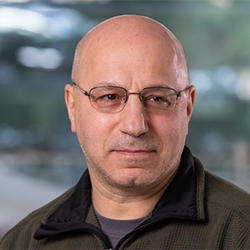How Certain Sounds Can Lead to More COVID-19 Spread
The characteristics of plosives lead to enhanced transport into the surrounding air
By now, we know plenty about how COVID-19 is transmitted from person to person. To avoid catching the virus, it’s prudent to wear a mask and stay socially distant whenever possible.
It’s also clear that speech is a potent route of transmission. Droplets and aerosols from one contagious person are sent into the air when they speak, risking the health of whoever is in close contact, or, in the case of the aerosols, whoever is sharing the air in the space. Masks, though effective, are taken off when you’re eating with friends, so there is a time period of speech in a reasonably close exchange.

Unfortunately, informed mitigation strategies are difficult to develop since the relationship of speech to the exhaled flow has not been documented, nor has the aerosolization mechanism in the oral cavity been visualized.
During his Dean’s Seminar Series virtual presentation “Fluid Dynamics of Speech: Mechanisms Underlying COVID-19 Transmission,” Princeton University’s Howard A. Stone used high-speed imaging to document the spatio-temporal structure of the expelled air flow and detail how those potentially dangerous drops are formed. Stone detailed how speaking louder can project more droplets, and how the characteristics of plosive sounds like “P” or “B” or “T” or “K”— produced by stopping airflow using the lips, teeth, or palate, followed by a sudden release of air — lead to enhanced transport into the surrounding air.
“The strong plosives will start to propagate out towards one meter, and they tend to carry the air in front of them and effectively push them forward,” said Stone, the Donald R. Dixon ’69 and Elizabeth W. Dixon Professor in Mechanical and Aerospace Engineering at Princeton. “If you average this kind of structure over time, what you tend to see is a conical region forming in front of you.”
Using high-speed imaging, Stone illustrated how phonation of common stop-consonants form and extend salivary filaments in a few milliseconds as moist lips open or when the tongue separates from the teeth. That produces centimeter-scale thin filaments, tens of microns in diameter, that break into speech droplets.
“This idea gets tied to speech because the lips open, the air flow stretches the droplets to thin the filament and lets it form smaller droplets,” Stone said.
What can be done to limit this risk? Stone suggested keeping your lips dry with lip balm.
“As long as your lips don’t contain a saliva film, you tend not to form droplets by this mechanism,” Stone said. “When you put lip balm on your lips, eventually your lips start to become wet again. This is at least one way to reduce the number of droplets that form when you speak.”
Of course, there is an additional way to limit the spread of potentially harmful droplets beyond keeping your lips dry and not maintaining a close conversation with another person.
“You know masks matter. Masks help,” Stone said. “If you visualize masks in the lab, the air flow gets out maybe 10 centimeters, so effectively the airflow is localized and you tend to be warm, so you produce a plume around you and then it more rapidly mixes with the surroundings.
“Masks have a huge effect on cutting off direct transmission between people.”